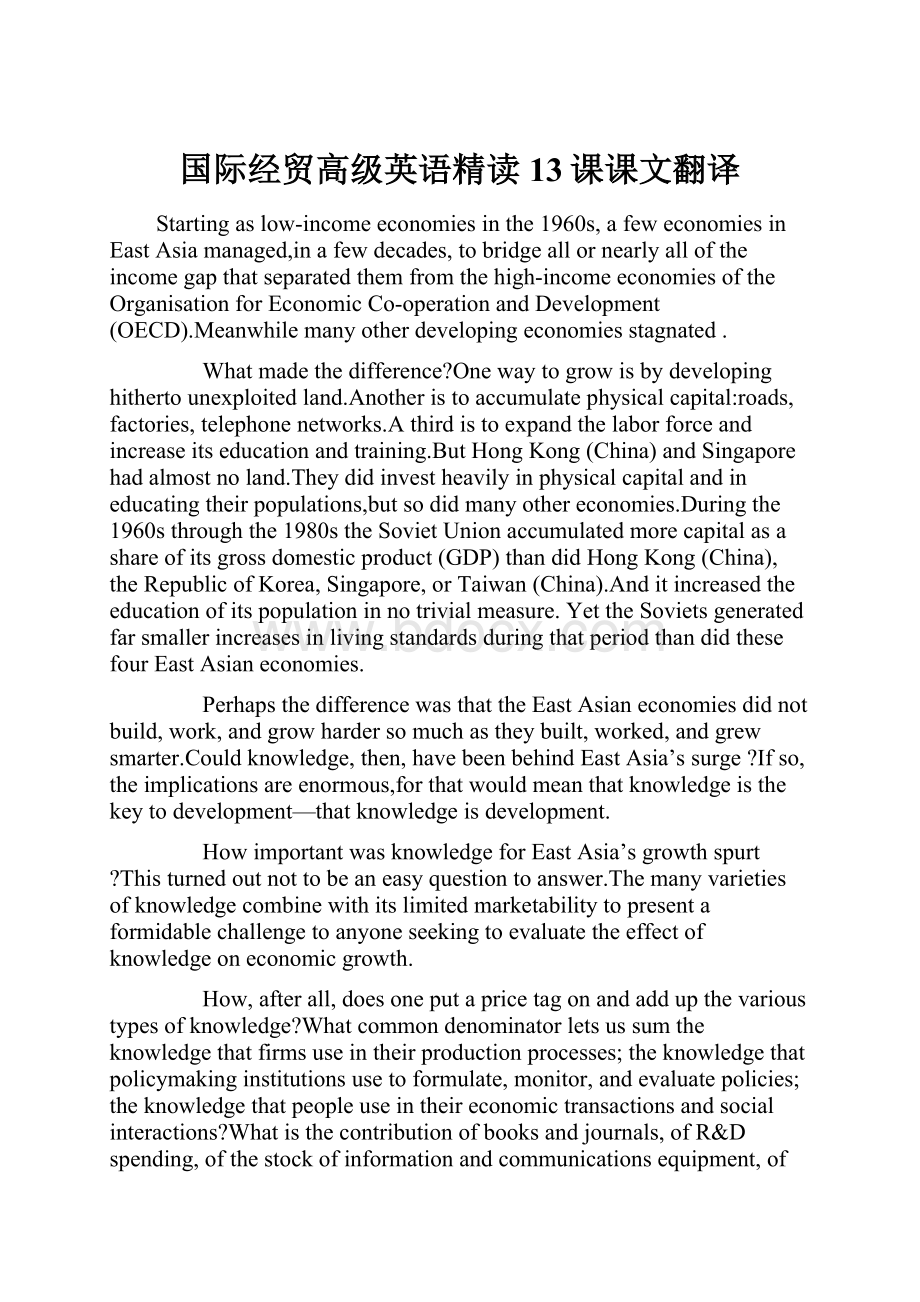国际经贸高级英语精读13课课文翻译.docx
《国际经贸高级英语精读13课课文翻译.docx》由会员分享,可在线阅读,更多相关《国际经贸高级英语精读13课课文翻译.docx(24页珍藏版)》请在冰豆网上搜索。

国际经贸高级英语精读13课课文翻译
Startingaslow-incomeeconomiesinthe1960s,afeweconomiesinEastAsiamanaged,inafewdecades,tobridgeallornearlyalloftheincomegapthatseparatedthemfromthehigh-incomeeconomiesoftheOrganisationforEconomicCo-operationandDevelopment(OECD).Meanwhilemanyotherdevelopingeconomiesstagnated.
Whatmadethedifference?
Onewaytogrowisbydevelopinghithertounexploitedland.Anotheristoaccumulatephysicalcapital:
roads,factories,telephonenetworks.Athirdistoexpandthelaborforceandincreaseitseducationandtraining.ButHongKong(China)andSingaporehadalmostnoland.Theydidinvestheavilyinphysicalcapitalandineducatingtheirpopulations,butsodidmanyothereconomies.Duringthe1960sthroughthe1980stheSovietUnionaccumulatedmorecapitalasashareofitsgrossdomesticproduct(GDP)thandidHongKong(China),theRepublicofKorea,Singapore,orTaiwan(China).Anditincreasedtheeducationofitspopulationinnotrivialmeasure.YettheSovietsgeneratedfarsmallerincreasesinlivingstandardsduringthatperiodthandidthesefourEastAsianeconomies.
PerhapsthedifferencewasthattheEastAsianeconomiesdidnotbuild,work,andgrowhardersomuchastheybuilt,worked,andgrewsmarter.Couldknowledge,then,havebeenbehindEastAsia’ssurge?
Ifso,theimplicationsareenormous,forthatwouldmeanthatknowledgeisthekeytodevelopment—thatknowledgeisdevelopment.
HowimportantwasknowledgeforEastAsia’sgrowthspurt?
Thisturnedoutnottobeaneasyquestiontoanswer.Themanyvarietiesofknowledgecombinewithitslimitedmarketabilitytopresentaformidablechallengetoanyoneseekingtoevaluatetheeffectofknowledgeoneconomicgrowth.
How,afterall,doesoneputapricetagonandaddupthevarioustypesofknowledge?
Whatcommondenominatorletsussumtheknowledgethatfirmsuseintheirproductionprocesses;theknowledgethatpolicymakinginstitutionsusetoformulate,monitor,andevaluatepolicies;theknowledgethatpeopleuseintheireconomictransactionsandsocialinteractions?
Whatisthecontributionofbooksandjournals,ofR&Dspending,ofthestockofinformationandcommunicationsequipment,ofthelearningandknow-howofscientists,engineers,andstudents?
Compoundingthedifficultyisthefactthatmanytypesofknowledgeareaccumulatedandexchangedalmostexclusivelywithinnetworks,traditionalgroups,andprofessionalassociations.Thatmakesitvirtuallyimpossibletoputavalueonsuchknowledge.
Reflectingthesedifficultiesinquantifyingknowledge,effortstoevaluatetheaggregateimpactofknowledgeongrowthhaveoftenproceededindirectly,bypostulatingthatknowledgeexplainsthepartofgrowththatcannotbeexplainedbytheaccumulationoftangibleandidentifiablefactors,suchaslabororcapital.Thegrowthnotaccountedforbythesefactorsofproduction—theresidualinthecalculation—isattributedtogrowthintheirproductivity,thatis,usingtheotherfactorssmarter,throughknowledge.ThisresidualissometimescalledtheSolowresidual,aftertheeconomistRobertM.Solow,whospearheadedtheapproachinthe1950s,andwhatitpurportstomeasureisconventionallycalledtotalfactorproductivity(TFP)growth.SomealsocalltheSolowresidualameasureofourignorance,becauseitrepresentswhatwecannotaccountfor.Indeed,wemustbecarefulnottoattributeallofTFPgrowthtoknowledge,ortheremaybeotherfactorslurkingintheSolowresidual.Manyotherthingsdocontributetogrowth—institutionsareanexample—butarenotreflectedinthecontributionsofthemoremeasurablefactors.Theireffectis(sofar)inextricablywovenintoTFPgrowth.
InearlyTFPanalyses,physicalcapitalwasmodeledastheonlycountry-specificfactorthatcouldbeaccumulatedtobetterpeople’slives.Technicalprogressandotherintangiblefactorsweresaidtobeuniversal,equallyavailabletoallpeopleinallcountries,andthuscouldnotexplaingrowthdifferencesbetweencountries.TheircontributionstogrowthwerelumpedwiththeTFPgrowthnumbers.Althoughthisassumptionwasconvenient,itquicklybecameobviousthatphysicalcapitalwasnottheonlyfactorwhoseaccumulationdroveeconomicgrowth.Astudythatanalyzedvariationsingrowthratesacrossalargenumberofcountriesshowedthattheaccumulationofphysicalcapitalexplainedlessthan30percentofthosevariations.Therest—70percentormore—wasattributeddirectlyorindirectlytotheintangiblefactorsthatmakeupTFPgrowth(Table1.1).
Laterattemptsintroducedhumancapitaltobetterexplainthecausesofeconomicgrowth.Ahigherlevelofeducationinthepopulationmeansthatmorepeoplecanlearntousebettertechnology.Educationwassurelyakeyingredientinthesuccessoffourofthefastest-growingEastAsianeconomies:
HongKong(China),theRepublicofKorea,Singapore,andTaiwan(China).Beforetheirtransformationfromdevelopingintoindustrializingeconomies,theirschoolenrollmentrateshadbeenmuchhigherthanthoseofotherdevelopingcountries(Table1.2).Theyhadalsoemphasizedadvancedscientificandtechnicalstudies—asmeasuredbytheirhigherratiosofstudentsintechnicalfieldsthaninevensomeindustrialcountries—thusenhancingtheircapacitytoimportsophisticatedtechnologies.Moreover,theimportanceofeducationforeconomicgrowthhadlongbeenrecognizedandestablishedempirically.Onestudyhadfoundthatgrowthinyearsofschoolingexplainedabout25percentoftheincreaseinGDPpercapitaintheUnitedStatesbetween1929and1982.
Addingeducationreducedthepartofgrowththatcouldnotbeexplained,thusshrinkingthehaystackinwhichTFPgrowth(andknowledge)remainedhidden.Someanalystsevenconcluded,perhapstooquickly,thatphysicalandhumancapital,properlyaccountedfor,explainedallorvirtuallyalloftheEastAsianeconomies’rapidgrowth,leavingknowledgeasaseparatefactoroutofthepicture.OnereasontheseanalystscameupwithlowvaluesforTFPgrowthisthattheyincorporatedimprovementsinlaborandequipmentintotheirmeasurementoffactoraccumulation.SoeventheirevidenceoflowTFPgrowthinEastAsiadoesnotrefutetheimportanceofclosingknowledgegaps.Indeed,itshowsthatthefast-growingEastAsianeconomieshadasuccessfulstrategytocloseknowledgegaps:
byinvestingintheknowledgeembodiedinphysicalcapital,andbyinvestinginpeopleandinstitutionstoenhancethecapabilitytoabsorbanduseknowledge.
LookingbeyondEastAsia,othergrowthaccountingstudieshaveexaminedlargersamplesofcountries.Evenwhenhumancapitalisaccountedfor,theunexplainedpartofgrowthremainshigh.Onesuchstudy,of98countrieswithanunweightedaveragegrowthrateofoutputperworkerof2.24percent,foundthat34percent(0.76percentagepoint)ofthatgrowthcamefromphysicalcapitalaccumulation,20percent(0.45percentagepoint)fromhumancapitalaccumulation,andasmuchas46percent(justover1percentagepoint)fromTFPgrowth.Evenmoreremainstobeexplainedinvariationsingrowthratesacrosscountries.Thesamestudyfoundthecombinedroleofhumanandphysicalcapitaltobeaslowas9percent,leavingtheTFPresidualatastaggering91percent.Totakeanotherexample:
KoreaandGhanahadsimilarlylowincomespercapitainthe1950s,butby1991Korea’sincomepercapitawasmorethanseventimesGhana’s.Muchofthatgapremainsunexplainedevenwhenhumancapitalistakenintoaccount.
Alltheseresultsaresubjecttomeasurementproblems.Forexample,themeasuredstockofhumancapitalmayoverstatetheactualquantityusedinproducinggoodsandservices.Highratesofschoolenrollmentorattainment(yearscompleted)maynottranslateintohigherratesofeconomicgrowthifthequalityofeducationispoor,orifeducatedpeoplearenotemployedattheirpotentialbecauseofdistortionsinthelabormarket.
Moreover,itisnowevidentthateducationwithoutopennesstoinnovationandknowledgewillnotleadtoeconomicdevelopment.ThepeopleoftheformerSovietUnion,likethepeopleoftheOECDcountriesandEastAsia,werehighlyeducated,withnearly100percentliteracy.Andforaneducatedpopulationitispossible,throughforeigndirectinvestmentandothermeans,toacquireanduseinformationaboutthelatestproductionandmanagementinnovationsinothercountries.ButtheSovietUnionplacedsevererestrictionsonforeigninvestment,foreigncollaboration,andinnovation.Itsworkforcedidnotadaptandchangeasnewinformationbecameavailableelsewhereintheworld,andconsequentlyitseconomysufferedadecline.
(excerptedfromWorldDevelopmentReport1998/1999)
一些东亚国家在20世纪60年代还是低收入国家,但是在短短的几十年之间,他们成功地弥补了其与经济合作与发展组织(OECD)中高收入国家之间的差距;与此同时,也有许多发展中国家的经济停滞不前。
造成这种差距的原因是什么呢?
发展的途径之一便是开发未开垦过的土地;之二是积累实物资本,例如公路,工厂,电话网络;之三则是增加劳动力数量并提高教育培训程度。
但香港(中国)和新加坡土地资源稀少,他们确实在实物资本和国民教育上投资不少,但其他许多国家也是这样做的。
在20世纪60年代到80年代,前苏联每年资本积累所占GDP的比重要高于香港(中国)、韩国、新加坡和台湾(中国),而且它在提高本国民众的教育水平上也是不遗余力,但这一时期前苏联国民生活水平的提高却远远落后于这四个东亚经济体。
也许差别在于:
东亚国家在建设、管理和发展其经济方面,与其说他们是苦干了,不如说他们是巧干了。
那么难道是知识支撑了东亚的崛起?
如果真是这样,那么其蕴含的意义将是深远的,因为这就意味着知识是发展的关键因素——知识就是发展。
知识对东亚经济的快速增长有何重要意义?
事实证明这是一个复杂的问题。
各种知识与其有限的可销售性相结合给人们带来了巨大的挑战,这就使得评估知识对于经济增长的作用变得极其困难。
毕竟,我们如何才能对种类繁多的知识产品进行标价和合计?
有什么共同标准使我们可以计算企业在其生产过程中使用的知识量;我们如何计算决策机构用了多少知识来制定、监管和评估其政策?
我们如何计算人们用了多少知识来从事经济活动和社会活动?
书刊,研究与开发的支出,信息与通信设备存量,科学家、工程师和学生们的学习与技术能力等要素各自的贡献有多大?
更为复杂的是,许多知识实际上是在网络上、传统群体内和学术组织之间积累和交流的。
那就使评估这种知识的可能性更加渺茫。
考虑到量化知识的困难,人们通常都用了间接的方式来衡量知识在经济增长中的总效果。
我们假设:
凡是经济增长中那些不能被有形的要素(如劳动力和资本)所解释的部分,都用知识来解释。
因为增长中不能由有形生产要素所解释的部分——计算中的残差——都归功于要素生产率的提高;也就是说,我们通过知识更有效地利用了其它的要素。
这种残差有时被称为“索洛残差”,得名于经济学家罗伯特·M·索洛,他在20世纪50年代率先提出这一方法;这一方法所要度量的就是通常所称的全要素生产力(